What Does a High Number of Continuity on Heating Lelements in Hot Water Heater Mean
If you're not getting enough hot water, you might suspect the water heater element is the culprit. Learn how to test water heater elements and get troubleshooting tips in our complete guide.
Disclaimer: REthority is supported by ads and participation in affiliate programs. We may earn a commission when you click our links.The information included in this post is for informational purposes only and should not be taken as legal or financial advice.
Jump to:
- How Do You Test a Water Heater Element?
- Is a Bad Element the Culprit?
- How to Test Water Heater Elements
How Do You Test a Water Heater Element?
Electric water heaters rely on two heater elements (electrodes) inside the tank to heat the water to the perfect temperature. These are the lower and upper heating elements, both controlled by the water heater thermostat.
They're thick loops of metal that allow an electric current to flow through them and heat the water. These electric heating elements are meant to be completely immersed in water.
The Upper Element
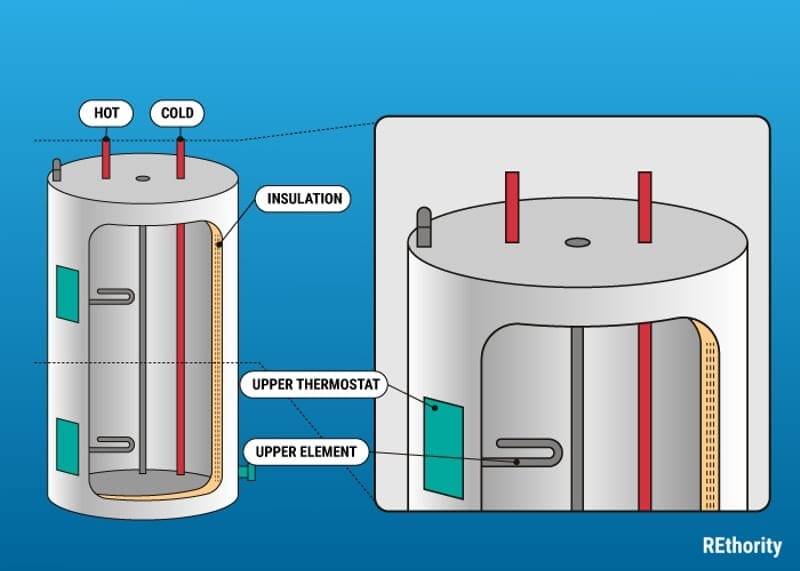
The upper water heater element has an easier job. It boosts the water temperature inside the tank back up to the set temperature when a lot of hot water is being used (and therefore, a lot of incoming cold water is entering the tank).
It's positioned in the top part of the tank, so it's just boosting water to the right temperature just before it leaves the tank for use.
The Lower Element
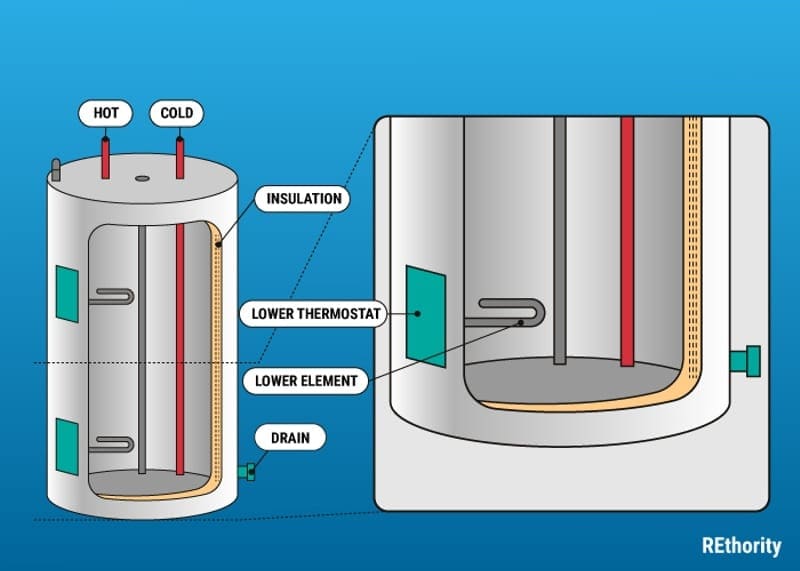
The lower water heater element works the hardest. When cold water enters your water heater tank through the dip tube, it shoots straight down to the bottom of the tank.
Here, the lower heater element is in charge of bringing that cold water up to the right temperature. It's on more often and usually is the first heater element to burn out.
Both heater elements do wear out over time, can become damaged, short-circuit, and can even become covered in sediment or scale. Any of these issues leads to noticeable problems with your hot water.
You might be dealing with one of these major symptoms of a bad water heater element:
- You have just as much "hot" water as you usually do, but now it's only lukewarm
- Your home has hot water, but it runs out much faster than it usually does
- Your water heater keeps tripping the circuit breaker over and over
Before you call a professional, it's a good idea to make sure it's the water heater element causing the problem.
Learn about detailed symptoms of heater element problems, how to test water heater elements, and how to pinpoint the problem next.
Is a Water Heater Element the Culprit?
Determining whether or not the problem is due to one or both of your electric water heater elements is pretty simple. Here are the different symptoms to look for. Which scenario sounds like yours?
1. Bad Lower Heater Element
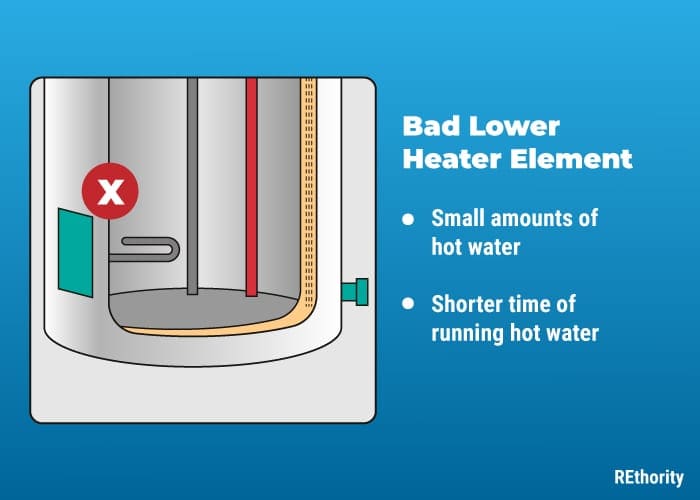
When a lower heater element has burned out, you'll notice that your water is as hot as ever, but you only get small amounts of it. You might only have a few minutes of hot water before it turns cold.
This is because the lower heater element has the important job of heating all the water in the tank to a baseline temperature. In contrast, the upper heater element gives it a final heat boost before it leaves the tank.
If the lower heater element is no longer working, the only hot water you're getting is the water at the very top of the tank that gets heated by the upper element.
The rest of the water stays cold (just as it was when it entered the tank) because the lower heater element isn't working. The upper heating element is like a sprinter, while the lower heater element is like a marathon runner.
The upper heater element isn't enough to heat all the water in the tank, but it can heat small amounts of water at the top to the right temperature.
If you're experiencing hot water that is the right temperature at first but quickly runs out, suspect the lower heater element. As the guys at Inspectapedia put it, "Short hot shower – bad bottom water heater element."
2. Bad Upper Heater Element
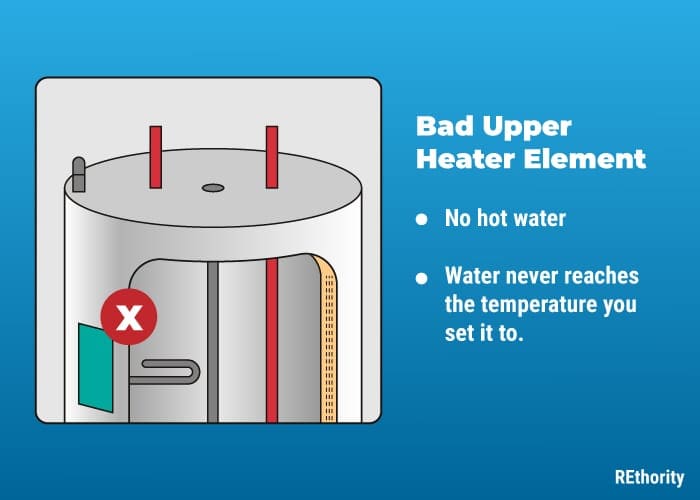
When an upper heater element has burned out, you'll notice that your water no longer gets hot at all. You'll have a good supply of lukewarm or tepid water that never reaches the temperature your water heater thermostat is set to.
This is because the upper heating element is no longer doing its job of giving your heated water that final boost in temperature before it leaves the tank.
The bottom heater element is still working to heat all the water in the tank to a certain temperature, but it's not powerful enough to take over the job of the upper heater element, too.
If you're experiencing plenty of lukewarm water (it doesn't run out quickly) that just never seems to heat up to the right temperature, suspect the upper heater element.
3. Shorted Heater Element
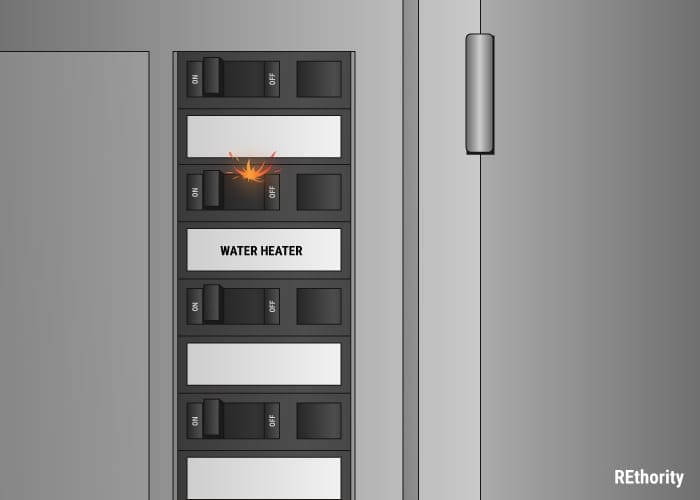
When a heater element is grounded and creates an electrical short, you'll notice because your water heater will continually trip the circuit breaker. You can reset it, and it will trip again, over and over.
You will also notice either hot water that is the right temperature, but very little of it, or (if both heater elements have failed) no hot water at all.
Water heater elements, when they fail, will either fail open or shorted. An open fail is what usually happens – the element just stops working.
A shorted fail happens when the electrical current supplied to the heater element bypasses the resistor. This means more current flows through than usual and signals the breaker to trip as a safety precaution.
When a water heater element fails, it can actually split open. This puts the electrified heating element directly into the water in the tank (it's normally covered by a metal tube).
This is rare, but it does happen. Once the electrified heater element touches the water, it causes a short circuit. This should trigger the thermostat to trip the circuit breaker.
In even rarer circumstances, the thermostat may not trip the circuit breaker when a heater element splits open. The result is electrified water that shocks you when it comes out of the tap.
This is incredibly dangerous and could be fatal. Immediately stop use and call a professional if you've experienced a shock from your water.
A shorted heater element isn't the only reason your water heater may trip the circuit breaker. A faulty thermostat could also be the culprit. The thermostat ensures only one heater element is on at any given time.
If it fails and turns both heater elements on at once, the increased electrical current flowing through the water heater could cause your circuit breaker to trip.
4. Scale Deposits on Heater Element
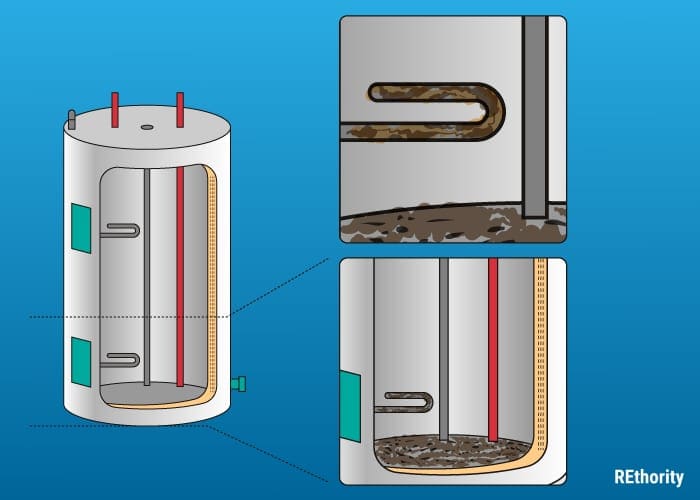
Calcium, magnesium, aluminum, iron, and silica in your water will eventually create scale inside your water heater. Scale forms when the heat inside your water heater chemically separates calcium and other mineral salts from the water.
Solids then accumulate on the heater elements and the bottom of the tank. Over time, scale deposits can completely encrust your heater elements. This is a problem for two reasons.
First, scale limits the efficiency of the heater element. The scale acts as an insulator. It prevents the heater element from efficiently heating the water around it because it reduces the surface area that contacts the water.
Second, scale causes the heater element to burn out faster. This is because the thermostat senses that the water still hasn't come to the right temperature, so it continually signals the heater element(s) to turn on.
But because the element is covered in scale, it still can't bring the water to the right temperature as quickly as it should. A scale-covered heater element that stays on for long periods will burn out quickly.
Overall, scale on your heater elements means you'll notice less hot water, water that isn't hot enough, and eventually (if both elements are covered in scale and burn out), no hot water.
You may also hear popping, crackling, or banging sounds from your water heater. Don't panic, but don't take a chance either.
These sounds occur when the minerals on the heater elements and bottom of the tank get moved around and cause steam bubbles when the elements turn on.
How to Test Water Heater Elements
Here are step by step instructions for testing water heater elements that you suspect are not working or may be shorted out. These tests require you to use a multimeter or other continuity tester.
Important: Use extreme caution when performing any of these tests, as electric shock is a risk that can be fatal. Do not test live wires. Ensure the power is turned off at the breaker before testing. Consult a professional if you do not feel comfortable performing these tests.
Test Water Heater Elements for Current Flow
- IMPORTANT: Turn off the electrical power to the water heater at the main electrical panel.
- Wait for the water in the water heater to cool down. You can run hot water from a tap until it flows lukewarm.
- Disconnect the electrical wires at both heating element terminals on the outside of your water heater tank.
- Set your VOM, DMM, Ohmmeter, or multimeter to read "resistance" or "ohms." Touch one probe or connect one alligator clip to each terminal on the upper water heater element. You are testing for current flow, or continuity.
- Check the reading. If the Ohmmeter needle does not move or the DMM gives no reading, the heater element is bad and should be replaced.
- If the Ohmmeter needle does move or get an Ohm reading other than infinity, the heater element is working fine and does not need to be replaced.
- Repeat the process to test the lower heater element and find which is the culprit.
Test Water Heater Elements for an Electrical Short
- IMPORTANT: Turn off the electrical power to your water heater at the main electrical panel.
- Remove the water heater's access cover panel and insulation from the upper water heater element. These are panels attached with screws on the tank of the water heater. Remove the screws and use gloves and goggles to remove the fiberglass or foam insulation it exposes.
- Connect the alligator clip or test terminal probe of your VOM or continuity tester to one terminal of the heating element.
- Connect the other clip or probe to a bracket or bolt that holds the heating element in its position.
- If the test buzzer goes off, the test light comes on, or the VOM reads continuity (set to Ohms), this indicates a short circuit in the heater element. It must be replaced by a professional. Do not turn the water heater back on or attempt to replace it yourself due to the risk of electrical shock.
- Test the other heater element using the same instructions.
While you can't really "test" for scale deposits without pulling the heater element out, you'll know it's a possibility if you have a combination of strange noises coming from your water heater along with:
- A reduction in hot water
- Plenty of lukewarm water
- Or no hot water at all (if the scale caused both elements to burn out)
Should You Test Water Heater Elements?
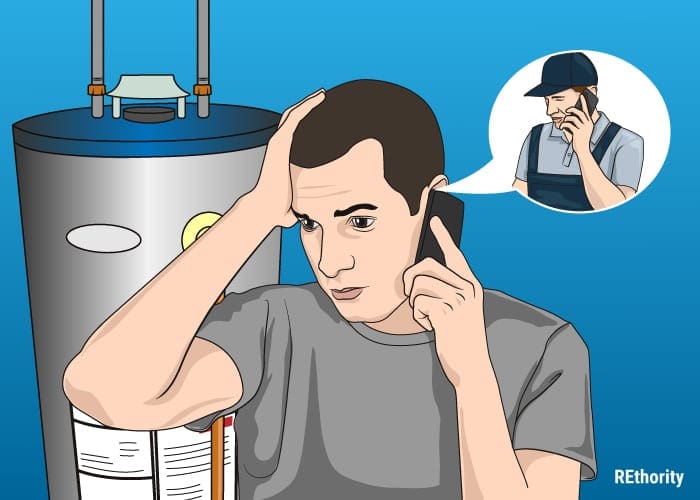
If you're not an electrical professional, you should leave electric water heater tests, repairs, and replacements to someone who is.
The risk of electrical shock is just too high for someone without plenty of experience working with these types of appliances. Most water heaters use 240 volts and require a 20-amp circuit to operate.
Human beings can be killed with as little as 42 volts and one-tenth ampere for just 2 seconds. The voltage and current of an electric water heater are more than enough to be fatal in the wrong hands.
Don't take the risk. Call a professional if you notice any problems with your water heater – they'll be able to proceed safely and get it fixed in no time.
You Might Also Like:
- No Hot Water: Troubleshooting Guide
- How to Turn off Water Heater
- How Long Do Water Heaters Last?
Source: https://rethority.com/how-to-test-water-heating-elements/
0 Response to "What Does a High Number of Continuity on Heating Lelements in Hot Water Heater Mean"
Post a Comment